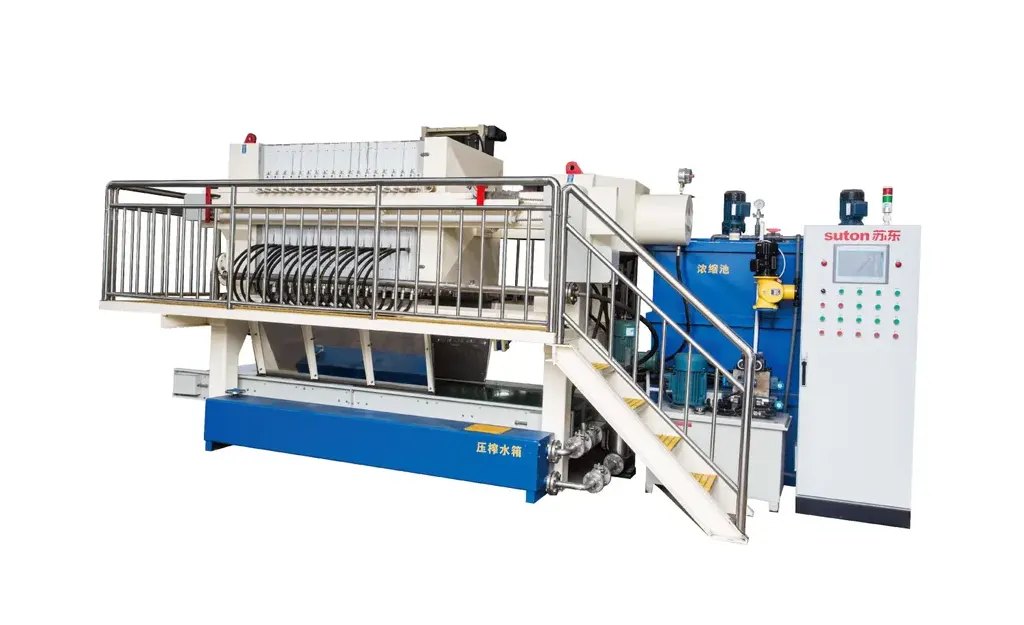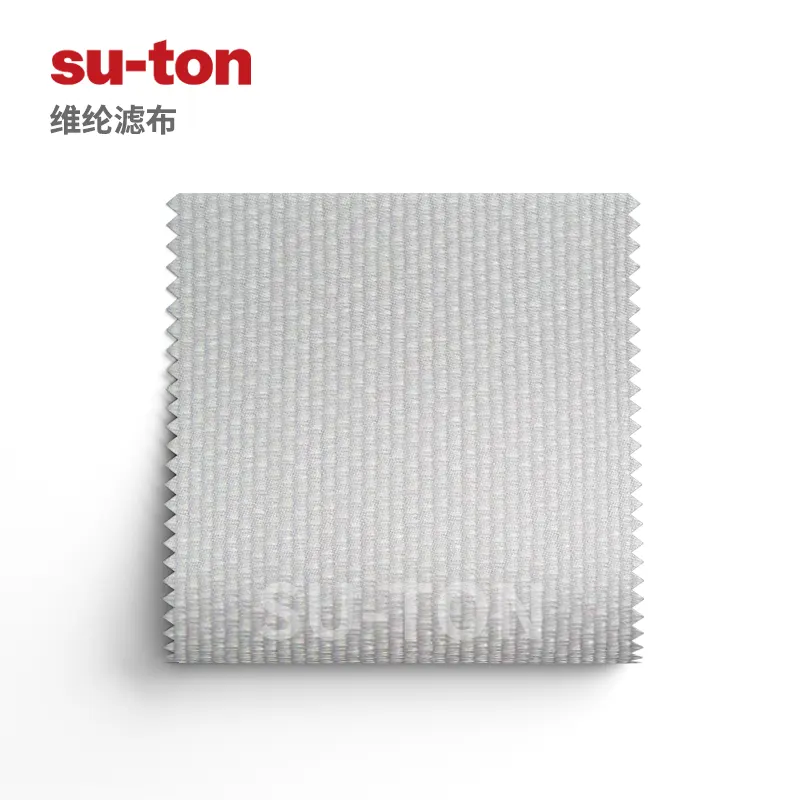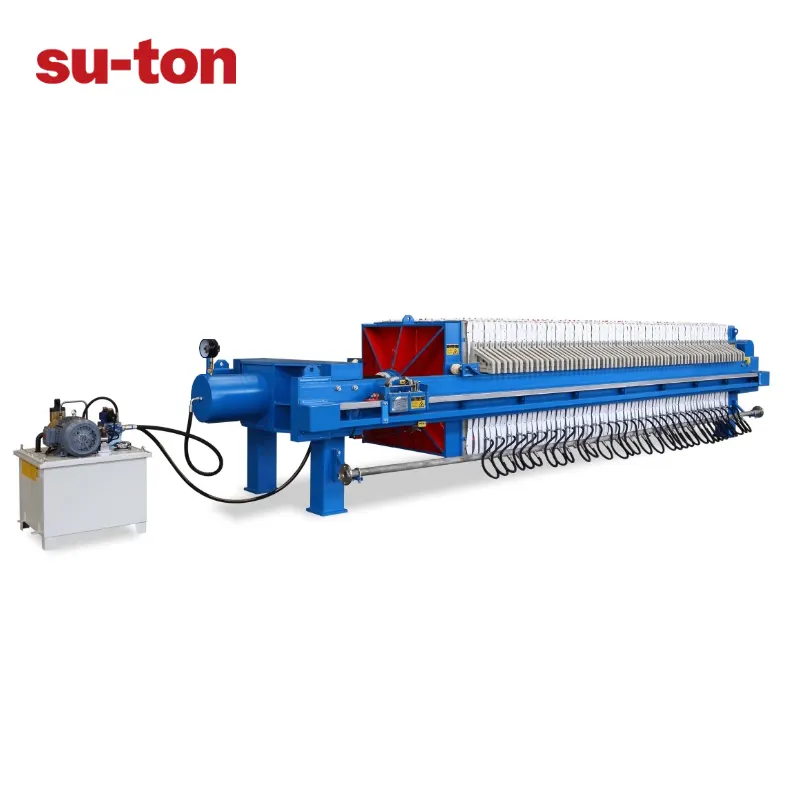introductory
Plate and frame filter pressIt is an intermittent filter press with a long history but still in use, which is widely used in environmental protection, chemical industry, coal, petroleum, food, pharmaceuticals and other industries, in the existing suspension mixture separation equipment, according to its ease of operation, cost and cost, the effect of de-liquefaction and other factors of comprehensive economic value.Plate and frame filter pressIt is one of the best separation equipment, which belongs to intermittent pressurised filter, with the advantages of compact structure and large filtering area, mainly used for filtering suspension with much solid content, because it can withstand high differential pressure, its operating pressure is generally 0.3-1.0MPa, so it can filter fine particles or materials with high liquid viscosity, it is one of the simplest and most widely used models in the pressurised filter structure at present [1]. With the country's increasingly high requirements for environmental protection and resource utilisation in all walks of life, the need for energy saving, emission reduction, cleaner production and green manufacturing is becoming more and more urgent. Plate and frame filter press, as the main equipment used in the field of environmental protection applications, is expected to have a substantial increase in market demand under the premise of increasingly high environmental protection requirements.

1.Plate and Frame Filter Press Patent Overview This paper is based on the patent data related to plate and frame filter press, and the search covers the global invention patent applications before May 2020 in the CNABS, DWPI, CNTXT, WOTXT, EPTXT, and USTXT databases, and the data after November 2018 is for reference only, as the patent applications may need to be published 18 months later. By combing the foreign patent applications for plate and frame filter presses, their changes in filing volume over the years and the main applicants. As can be seen from the foreign patent applications distributed by years, the foreign research on plate and frame filter press is relatively early, and the research in this field began at the end of the 18th century, and the number of patents filed before the 1960s is relatively small, but after the 1960s the growth momentum of applications is obvious, and the number of applications for this device reached a peak in the 1980s, and then slowly declined, and then reached the second at the beginning of the 21st century A small peak was reached in the early 21st century, followed by a spurt in 2012 and a decline in filings in recent years. In terms of the ranking of the number of applications, Otto Tec and JVK Filtration Systems occupy the top two positions, and the number of applications is more than twice that of Otto Kump, which is in the third position. As shown in Figure 3, through combing the sources of global patent applications, it is found that the patent applications in this technology field are mainly concentrated in China, accounting for 38% of the global application volume, followed by Germany, the United Kingdom, France and other European countries, and the United States also has a larger proportion of patent applications, Europe is thePlate and frame filter pressesThe earliest place of use, in Germany, France, the United Kingdom is widely used in the coal industry, chemical industry, medical and other filtration industries, after more than one hundred years of development, a new generation of plate and frame filter presses have appeared one after another, and the level of technology continues to improve.
The domestic plate filter press started late, and the overall level of applications was low in the 20 years from 1986 to 2006, and entered a period of rapid growth from 2007, and the annual application volume reached more than 140 in 2018, and the data in 2019 declined due to the impact of the patent publication cycle. It can be seen that the applicants in China have been continuously focusing on the technological research and development of plate and frame filter press. The main applicants of the top ten domestic patent applications. It can be seen that the main body of applicants in China is mainly companies, and research institutes and universities pay less attention.
2.Plate and frame filter press technology development route Plate and frame filter presses first appeared in Europe, in Germany, France, the United Kingdom in various industries, plate and frame filter presses are widely used, including coal, chemical, medical, textile and other fields. Over the years, the plate and frame filter press has been continuously developed and improved, and its structure has gone through many generations of changes, and the level of technical application has also been greatly improved. The development of plate and frame filter press can be divided into four stages:
(1) the first generation of plate and frame filter press in 1910, Britain invented the plate and frame type filter press, which sets the filter material in the plate and frame, and filters the slurry by squeezing the filter plate, but there is still a lot of water left in the filter cake, which is about 20%-22%. in the same year, the GB191026231A further proposed the improvement of the filter press plate, so that the metal plate has a pair of metal mesh fixed to the two sides by the wooden bar, and these wooden bars into a pair of metal mesh with serrated joints, and a conical plug is set in the drain slot of the bottom bar, which is fixed by screws or bolts on the tray, the metal buttons or washers. of a pair of wire meshes which are formed with serrated joints, with conical plugs in the drainage slots of the bottom bars, and with the trays strengthened by fixing strips of wood, metal buttons or washers to the trays by screws or bolts.In 1912 in GB191223867A it was proposed that the grates be constructed so as to have passages forming channels substantially parallel to the circumferences or sides of the passages, which passages are partitioned so as to provide perpendicular passages for air intake or exhaust. Filter presses of this generation have localised pressurisation, and so show significant advantages in the dewatering of suspensions of fine particle size and high viscosity. However, there are still problems such as long filter press time, high operating cost with small capacity, high consumption of filter cloth, short life of filter plate, intermittent production and high maintenance.
(2) The second generation of plate and frame filter presses made structural improvements to address the shortcomings of the first generation of plate and frame filter presses, and in GB2282722A proposed an improvement to the filter plate frame by supporting the edges of strips of paper or very thin filter media on both sides of the frame, with the filtrate flowing through channels formed in the bottom frame strips of the frame, or through slots cut in the strips; in 1930, GB346191A proposed further drying of the filter cake by suspending hollow heating elements in the frame, followed by a series of patent applications in the area of heating the filter cake; in 1953, GB718801A proposed to provide the hollow portion of the filter plate with gripping means having, at least on its edges, spacer surfaces comprising spacer surfaces capable of springing open and engaging on opposite sides of the edges of the apertures, the ports being fitted into the edges of the apertures to hold said portion in the plane of the plate, permitting easy removal thereof; in 1960, GB905098A proposed a filter plate of the type of housing structure for filtration with the aid of a filter aid; improvements during this period include filter plate construction (DE881639C, DE940527C, US2594518A), filter plate material (GB909045A), multiple feeds, filter plate support ( GB797880A, GB820668A), hydraulic cylinders, pull-open devices and automation, but also added a second pressing, that is, before the opening of the plate unloading to add a mechanical pressing process with a relatively short process time, further reducing the moisture in the filter cake.
(3) The third generation of plate and frame filter presses was introduced in Germany in 1969 in DE1960821B with diaphragm-type filter plates, i.e., each plate has a filter membrane with a slotted backside to form a filtrate channel between the plate and the membrane, and a sludge chamber or wall of a next door on the other side. The membranes are rolled down to fit over the edges of the plates and locked into the separating plane between neighbouring filter banks. In this plate mode, when the slurry fills the filter chamber, high-pressure air is pressed into the interlayer between the membrane and the plate, and the elasticity of the membrane is used to squeeze and dewater the cake, while a "blowing" process is used to replace the filtrate in the cake void with air to reduce the moisture in the cake again. 1980, Kurita Machinery Co. In 1980, in order to improve the dewatering rate of the filter cake, Kurita Machinery Manufacturing (JPS5794312A) in Japan ensured the passage of filtrate by providing a gap between the concave portion of the filter-pressing membrane and the open portion of the vertical holes, and the patent applications relating to diaphragm-type filter presses from the 1870s to the 1890s were very active and were mainly located in Germany, Japan, the United Kingdom, and the United States. The plastic diaphragm filter plate with filter cloth on both sides of the filter plate, when filled with high pressure gas for pressing, the diaphragm can fully press the filter cake, with less dead space and good pressing effect.
(4) the fourth generation of plate and frame filter press Sarah company designed the VP type filter press uses another form of "blowing process", after the "extrusion process" of the cake, the space between the particles and a certain amount of water, it can be assumed that the space between the particles for the length or diameter of different capillaries. or different diameter capillary, these capillary filtrate is very difficult to discharge through the "extrusion process". Therefore, the procedure of "blowing" was adopted to replace the filtrate in the gaps with pressurised air. When the pressurised air enters the capillary tubes of the filter cake, the liquid therein is gradually replaced by the air, and the moisture content of the cake will be reduced. In this process, the Chinese applicant has also proposed a series of improvements on the basis of the existing filter press, for example, for the defects in the diaphragm filter press in which the diaphragm ruptures after a long period of time, the whole operation process is long, and the sludge discharge requires one plate and one plate to be moved sequentially, it was proposed in CN102068840A in 2010 that there is an elastic press frame between the two filter plates, and that the elastic press frame forms a seal between the elastic press frame and the filter plate; South China University of Technology proposed in CN108465278A a high-pressure plate and frame filter press with retractable filter plates. Aiming at the problem of high water content of filter cake, a series of proposals on plate and frame filter presses with backblowing air drying are put forward, wherein each filter press plate is provided with an air guide pipe made of soft material, and the air inlet hole is connected to a high-pressure air pipe provided above the filter press through the air guide pipe to reduce the water content of the material to 181 TP3T-221 TP3T.
3.Outlook Plate and frame filter press belongs to an important part of solid-liquid separation equipment, and its development process in Europe has experienced more than a century. Although our patent system started late, so the patent application about plate and frame filter press is also relatively late, but the domestic researchers have summarised the existing technology well, put forward a series of improvements for the shortcomings of the existing technology, and the number of patent applications has been growing, which promotes the rapid development of China's filter press technology, and its patent protection network will also be more and more perfect.
Disclaimer: The copyright of this article belongs to the original author and the original source. Welcome to call us for consultation, technical exchanges, and material experiments.
 Plate and frame chamber diaphragm filter presses
Plate and frame chamber diaphragm filter presses




